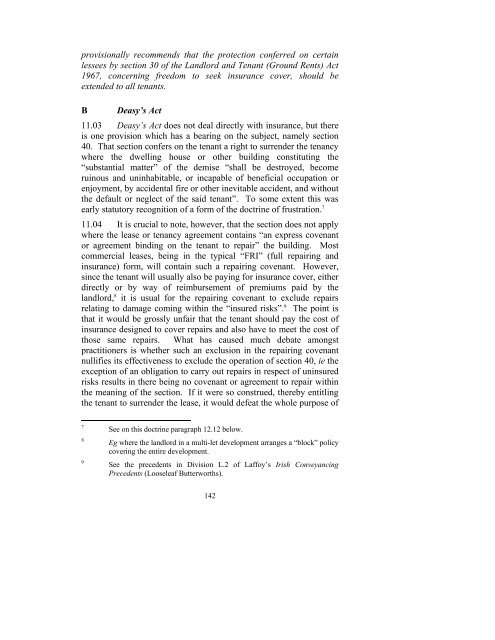Consultation Paper on the General Law of the Landlord and Tenant
Consultation Paper on the General Law of the Landlord and Tenant
Consultation Paper on the General Law of the Landlord and Tenant
Create successful ePaper yourself
Turn your PDF publications into a flip-book with our unique Google optimized e-Paper software.
provisi<strong>on</strong>ally recommends that <strong>the</strong> protecti<strong>on</strong> c<strong>on</strong>ferred <strong>on</strong> certainlessees by secti<strong>on</strong> 30 <strong>of</strong> <strong>the</strong> <strong>L<strong>and</strong>lord</strong> <strong>and</strong> <strong>Tenant</strong> (Ground Rents) Act1967, c<strong>on</strong>cerning freedom to seek insurance cover, should beextended to all tenants.B Deasy’s Act11.03 Deasy’s Act does not deal directly with insurance, but <strong>the</strong>reis <strong>on</strong>e provisi<strong>on</strong> which has a bearing <strong>on</strong> <strong>the</strong> subject, namely secti<strong>on</strong>40. That secti<strong>on</strong> c<strong>on</strong>fers <strong>on</strong> <strong>the</strong> tenant a right to surrender <strong>the</strong> tenancywhere <strong>the</strong> dwelling house or o<strong>the</strong>r building c<strong>on</strong>stituting <strong>the</strong>“substantial matter” <strong>of</strong> <strong>the</strong> demise “shall be destroyed, becomeruinous <strong>and</strong> uninhabitable, or incapable <strong>of</strong> beneficial occupati<strong>on</strong> orenjoyment, by accidental fire or o<strong>the</strong>r inevitable accident, <strong>and</strong> without<strong>the</strong> default or neglect <strong>of</strong> <strong>the</strong> said tenant”. To some extent this wasearly statutory recogniti<strong>on</strong> <strong>of</strong> a form <strong>of</strong> <strong>the</strong> doctrine <strong>of</strong> frustrati<strong>on</strong>. 711.04 It is crucial to note, however, that <strong>the</strong> secti<strong>on</strong> does not applywhere <strong>the</strong> lease or tenancy agreement c<strong>on</strong>tains “an express covenantor agreement binding <strong>on</strong> <strong>the</strong> tenant to repair” <strong>the</strong> building. Mostcommercial leases, being in <strong>the</strong> typical “FRI” (full repairing <strong>and</strong>insurance) form, will c<strong>on</strong>tain such a repairing covenant. However,since <strong>the</strong> tenant will usually also be paying for insurance cover, ei<strong>the</strong>rdirectly or by way <strong>of</strong> reimbursement <strong>of</strong> premiums paid by <strong>the</strong>l<strong>and</strong>lord, 8 it is usual for <strong>the</strong> repairing covenant to exclude repairsrelating to damage coming within <strong>the</strong> “insured risks”. 9 The point isthat it would be grossly unfair that <strong>the</strong> tenant should pay <strong>the</strong> cost <strong>of</strong>insurance designed to cover repairs <strong>and</strong> also have to meet <strong>the</strong> cost <strong>of</strong>those same repairs. What has caused much debate am<strong>on</strong>gstpractiti<strong>on</strong>ers is whe<strong>the</strong>r such an exclusi<strong>on</strong> in <strong>the</strong> repairing covenantnullifies its effectiveness to exclude <strong>the</strong> operati<strong>on</strong> <strong>of</strong> secti<strong>on</strong> 40, ie <strong>the</strong>excepti<strong>on</strong> <strong>of</strong> an obligati<strong>on</strong> to carry out repairs in respect <strong>of</strong> uninsuredrisks results in <strong>the</strong>re being no covenant or agreement to repair within<strong>the</strong> meaning <strong>of</strong> <strong>the</strong> secti<strong>on</strong>. If it were so c<strong>on</strong>strued, <strong>the</strong>reby entitling<strong>the</strong> tenant to surrender <strong>the</strong> lease, it would defeat <strong>the</strong> whole purpose <strong>of</strong>789See <strong>on</strong> this doctrine paragraph 12.12 below.Eg where <strong>the</strong> l<strong>and</strong>lord in a multi-let development arranges a “block” policycovering <strong>the</strong> entire development.See <strong>the</strong> precedents in Divisi<strong>on</strong> L.2 <strong>of</strong> Laffoy’s Irish C<strong>on</strong>veyancingPrecedents (Looseleaf Butterworths).142
















